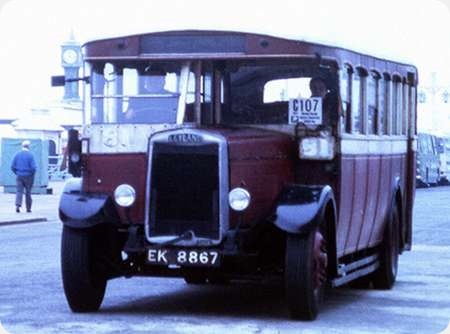Wigan Corporation – Leyland Tiger TS4 – EK 8867 – 81
Wigan Corporation
1932
Leyland Tiger TS4
Santus B32R
This picture of Wigan No.81 was taken on a dismal day in Brighton in May 1969 during the HCVC Rally. It shows a Leyland Tiger TS4 with locally Wigan built Santus B32R body delivered in October 1932. It has been established that the peculiarly Wigan name of Santus did not indicate a link between the coachbuilder and the confectionery manufacturer – see comments on this OBP page:- www.old-bus-photos.co.uk/?
The TS4 appeared in 1931 to compete with the AEC Regal, ironically designed by John Rackham who had created the Titan and Tiger models before migrating to Southall. It had a more robust chassis with a larger engine than the TS3, a new ‘silent third’ gearbox, a fully floating rear axle and triple servo brakes. In this 1969 picture EK 8867 is wearing a very faded Wigan livery which must surely be the one it wore upon withdrawal some time earlier, whenever that was – I have no Wigan fleetlist. It is now in proper preservation.
Photograph and Copy contributed by Roger Cox
15/02/22 – 05:48
More than anything, this photo shews how bodywork progressed in the seven or so years after 1931! What on earth was a ‘silent third’ gear: no screaming, or some sort of synchromesh device?
Chris Hebbron
16/02/22 – 06:26
The Leyland Tiger TS1, 2 and 3 versions were fundamentally the same chassis differing only in overall length and wheelbase. The TS4 was the single deck equivalent of the Titan TD2 and shared the same engine and transmission specifications. The four speed sliding mesh gearbox of the earlier models was replaced by one in which third speed was in constant mesh with helical cut gears giving a much quieter sound output, hence the ‘silent third’. This gearbox was subsequently employed in all standard Tigers and Titans up to the TS11 and TD7. Wigan No. 81 was delivered in October 1932 when Leyland’s initial diesel engine of 8.1 litres was only just being produced in quantity, and most of these went into Titans, so it almost certainly began service with the 7.6 litre petrol engine. The fact that it was still wearing its Wigan livery, albeit much faded, in 1969 suggests that it may well have been converted to diesel power during its period of service with the Corporation. The Leyland oil engine, later increased in capacity to 8.6 litres, was closely based upon the petrol unit, both being of overhead camshaft layout, and the compact design, unlike competing AEC and Gardner offerings, meant that it would fit within the same bonnet length as the petrol engine.
Roger Cox
05/03/22 – 06:24
A belated thx, Roger, for your comprehensive reply.
Chris Hebbron
Quick links to the - Comments Page - Contact Page - Home Page
Comments - Please note: The comments facility is not currently available. Please see the home page for updates.
Please Note if you want to send a photograph with your comment please use the Contact Page by clicking here or send as an attachment via email.

